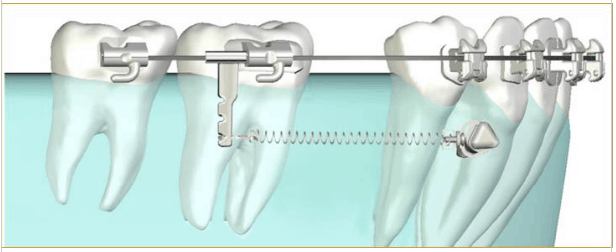
Orthodontic technology has made significant advancements in the past ten years, elevating the field and offering patients effective, affordable and less invasive treatment options. Cutting-edge technology and progressive orthodontic solutions are giving clinicians the tools to treat cases that three to five years ago would have been deemed too challenging. Today’s orthodontic patients, even those with difficult Class III cases, may achieve a precision smile without undergoing painful surgery and or enduring embarrassing headgear previously required for successful treatment. Temporary anchorage devices (TADs) are a prime example of how far the field of orthodontics has progressed in providing more advanced care to patients.
All orthodontic treatment requires either the jaws or teeth for anchorage – from which a force is applied to move the target teeth in one of two ways. The first method pits teeth against each other to force directional movement. However, teeth may not always be in the correct position or at the ideal angle to be used as anchorage. The second treatment method uses an extra-oral orthodontic anchorage – like headgear – to reposition teeth. Both methods can require lengthy treatment, produce a less predictable outcome and may increase discomfort.
TADs offer clinicians a third approach that transforms the way a full range of orthodontic cases may be treated. TADs are intelligently-designed sterile miniscrews, used to reposition teeth in a way that painlessly corrects structural oral deformations without surgery or extra-oral anchorage devices. Typically, TADs are made of titanium-alloy, ranging from six to 12 millimeters in length and 1.2 to two millimeters in diameter. The minicrews, often referred to as microimplants, closely resemble standard screws but on a much smaller scale. They provide clinicians with simplified mechanics that allow for force to be created without relying on teeth within the mouth to serve as anchors or calling on a clunky apparatus to create a resistance force. With TADs, a more precise anchorage site can be chosen by clinicians based on individual patient cases. This level of customization allows orthodontists to optimize the results and increase the level of tooth movement that’s achievable.
The miniscrews provide a fixed point or resistance force from which clinicians can apply the force needed to guide teeth into the ideal position. TADs can be easily inserted into the bone between the teeth or the bone located in the roof of the mouth. The stationary anchors are then most frequently attached to braces with TAD-specific auxiliaries such as coil springs, providing a stable anchorage point that can withstand the force needed to realign teeth. TADs application is simple; four TADs can be applied in fifteen minutes with minimal patient discomfort and can be removed in even less time.
TADs have the greatest impact on patient cases requiring significant jaw realignment due to a number of orthodontic conditions – including molar intrusion, molar protraction, en mass anterior retraction, molar uprighting, extruding impacted cuspids, closing anterior open bites and leveling occlusal cants. Before the use of miniscrews, a patient with an overdeveloped upper jaw required a complex surgery comprised of cutting away the jaw bone and moving the upper jaw to remove the excess gum tissue. By positioning TADs in the upper jaw and attaching them to archwires, clinicians are able to correct an overdeveloped upper jaw without any surgical procedures. In ideal cases, within seven to eight months the upper jaw can be successfully moved into a new position for far less than an estimated $15,000 to $20,000 jaw surgery.
While only a small percentage of all orthodontic patients require TADs, these patients are experiencing drastic improvements in the quality of treatment and results. TAD treatment is suitable for almost all healthy patients who do not show signs of active periodontal disease and is recommended when existing teeth are not suitable or insufficient for anchorage.
If you’re considering orthodontic treatment with TADs, such as VectorTAS, there are several treatment benefits. TAD-based procedures usually only require a minor local anesthetic and may be completed without pain or bleeding, given the minimally invasive nature of the insertion process. After treatment is completed, the miniscrews are easily removed. A few more advantages of TADs include:
- Increased comfort
- Increased convenience
- More predictable and precise results—without headgear or surgery
- Targeted insertion where clinicians believe they will provide the most benefit
- Shorter treatment time
- Immediate use after implantation
- Easy and painless removal
- Quick recovery: insertion sites heal quickly upon removal of TADs
VectorTAS, a specific brand of TADs, is popular today among highly-skilled orthodontists because the technology is clinically proven to be one of the most stable screws on the market. The intelligently-designed miniscrews, TAD-specific attachments and instruments are optimized to deliver maximum strength, stability and clinical precision. VectorTAS was created by a team of leading orthodontists to minimize any possible tissue aggravation and increase oral comfort for TADs patients.
If you are considering undergoing orthodontic treatment, it is always best to work with a professional that is up to date on evolving orthodontic technology and can offer an effective treatment plan that minimizes your time in the chair and produces healthy results. I encourage you to speak openly and honestly with your orthodontist about the results you are hoping to achieve.
 Dr. John Graham is a practicing orthodontist in Salt Lake City, Utah. and a renowned innovator and educator in the field, lecturing worldwide to both doctors and staff on the most advanced orthodontic treatment philosophies available. He is also a physician. He is the co-author of several orthodontic textbook chapters, and has written many professional journal articles. He is a member of the American Dental Association, American Medical Association, American Association of Orthodontists, Arizona Dental Association, Pacific Coast Society of Orthodontists and the Progressive Orthodontic Study Club. Dr. Graham is a contributing editor for both the Journal of Clinical Orthodontics and Orthotown, and is a reviewer for the journal ORTHODONTICS: The art and practice of dentofacial enhancement. Dr. Graham is on faculty at both the University of the Pacific, Arthur A. Dugoni School of Dentistry, and the University of Rochester, Eastman Institute for Oral Health and he is a past president of the Arizona Orthodontic Association.
Dr. John Graham is a practicing orthodontist in Salt Lake City, Utah. and a renowned innovator and educator in the field, lecturing worldwide to both doctors and staff on the most advanced orthodontic treatment philosophies available. He is also a physician. He is the co-author of several orthodontic textbook chapters, and has written many professional journal articles. He is a member of the American Dental Association, American Medical Association, American Association of Orthodontists, Arizona Dental Association, Pacific Coast Society of Orthodontists and the Progressive Orthodontic Study Club. Dr. Graham is a contributing editor for both the Journal of Clinical Orthodontics and Orthotown, and is a reviewer for the journal ORTHODONTICS: The art and practice of dentofacial enhancement. Dr. Graham is on faculty at both the University of the Pacific, Arthur A. Dugoni School of Dentistry, and the University of Rochester, Eastman Institute for Oral Health and he is a past president of the Arizona Orthodontic Association.
In 2018, Henry Schein® Orthodontics™ (HSO) announced Dr. Graham’s, appointment to their Clinical Advisory Board.
You can visit Dr. Graham’s website at: https://grahamortho.com/

